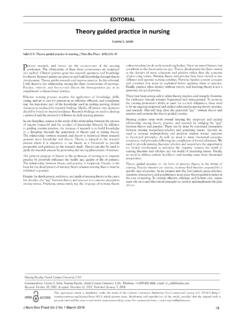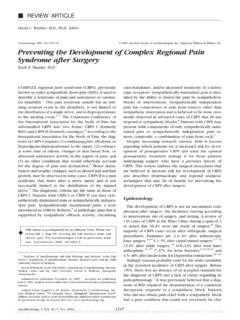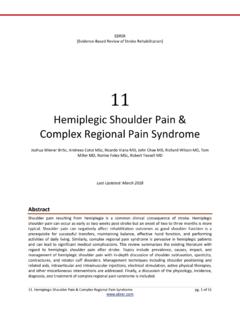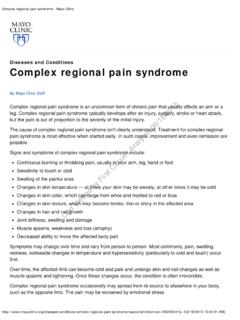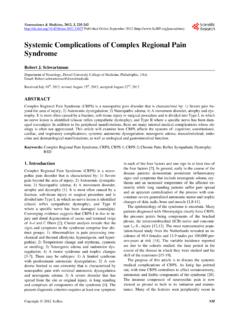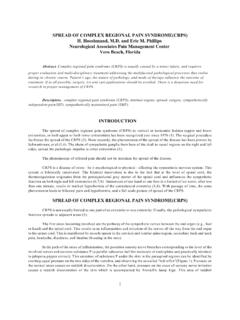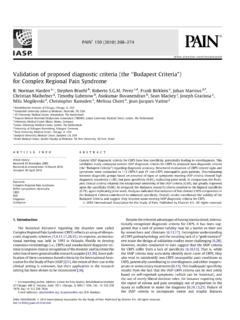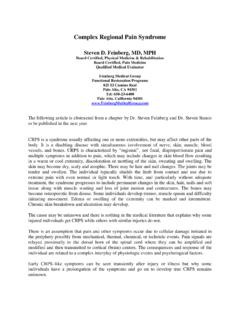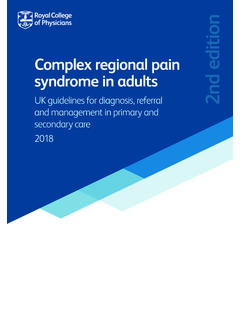Transcription of New protocol for treatment of complex regional pain ...
1 New protocol for treatment of complex regional pain syndrome : a case seriesJohnathan Goree1*, Dustin Rumpel1, and Daniel Judkins2 Goree J, Rumpel D, Judkins D, et al. New protocol for treatment ofcomplex regional pain syndrome : a case series. Anesthesiol Case ;1(1) regional pain syndrome is a rare condition that causesdebilitating pain and loss of mobility to one or more extremities. Whilemultiple tools have been developed to diagnose this disease, the treatmentscurrently employed are highly variable and the results are unpredictable. Inorder to address this, we did a review of the literature and created astandardized six week complex regional pain syndrome treatment protocolwhich included many treatments with proven benefit employedsimultaneously. In this article, we present our brief literature review, ourstandardized protocol , and three case reports of patients who hadsuccessful treatment of their disease with our newly established also present a discussion detailing why we feel that this protocol hasprovided benefits in these first three Words: complex regional pain syndrome ; Stellate Ganglion Block;Bisphosphonates; Gabapentin; Dorsal Column StimulationINTRODUCTIONC omplex regional pain syndrome (CRPS) is a rare but debilitating diseasewith an incidence of approximately 26 cases per 100,000 person years in apopulation study from the Netherlands [1].
2 Although the underlyingpathophysiology remains incompletely understood, the hallmark of thedisease is regional pain with multisystem involvement presenting withsymptoms of swelling, vasomotor changes, loss of mobility, and trophicchanges. While the International Association for the Study of Paindeveloped the Budapest Criteria in 2003 to further standardize thediagnosis of CRPS, there has been little standardization of treatment ofthis disease [2]. Physical and occupational therapy (PT/OT) have beenshown to provide benefit, but prolonged patient participation can bechallenging due to severity of symptoms and lack of motivation [3]. Whilesome medications and procedural interventions have shown promise,literature and randomized trials supporting these measures have remainedsparse [3]. To facilitate active participation in occupational therapy (OT),we have created a standardized protocol for the treatment of upperextremity CRPS which includes many treatment modalities with literatureproven benefit.
3 In this publication, we will review the literature discussingthe individual pieces of our protocol . We will discuss the implementationand the four tenets of our protocol . We will present a case series of the firstthree cases in which this protocol was implemented. Lastly, we will endwith a discussion of why we feel that this approach to the treatment of thisdisease has been a benefit to our patients at our is a large amount of variation in the current treatment of physicians use a number of familiar medications that have beenproven to have some benefit in the treatment of neuro-inflammatory , many of these medications have either not been studied inCRPS patients or have shown poor or partial efficacy. Here, we willreview a number of commonly used medications and interventions thathave shown evidence of benefit in : The largest study of gabapentin for patients with CRPS wasdone by van de Vusse in 2004.
4 This study randomized 58 patients to eitherplacebo or gabapentin 600mg TID. While gabapentin did not show asignificant benefit in pain scores, it significantly improved Mann-Whitneymonofilament application scores in the lower extremity. This is often usedas a surrogate for allodynia and hyperalgesia [4]. While this alone may notcause a clinically significant change in a patient s outcome, gabapentin asa part of a multimodal approach has the potential to allow for a patient tobetter tolerate other modalities of treatment including : In multiple studies, bisphosphonates, both intravenousand oral, have demonstrated a statistically significant improvement in thevisual analogue pain scale [5]. In a study by Varenna, 82 patients wererandomized to four treatments over 10 days of either an IV infusion ofneridronate or placebo. While there was a statistically significantimprovement in VAS at 20 days, this improvement gap continued to widenat day 40 [6].
5 In as second study by Manicourt, 40 patients wererandomized to 40 mg daily of alendronate for 8 weeks. In contrast to theplacebo treated patients, all bisphosphonate treated patients showedimprovement to spontaneous pain , pressure tolerance, and joint mobility[7].Ketamine: Intravenous ketamine has shown a significant reduction in painscores and improvement of function but there are challenges in itscontinued administration [8,9]. One is that Kim et al. published a studywhich demonstrates a decrease in executive function in patients with longterm ketamine use [10]. Another is that the cost of administration preventsits universal use. While topical ketamine has not shown similar reductionin pain scores, the literature has illuminated some improvement inallodynia and hyperalgesia. In a study by Finch in 2009, 20 patients wererandomized to either 10% topical Ketamine or placebo.
6 The Ketaminepopulation was found to have a significant improvement in limb could also be used to further facilitate participation in therapy anddesensitization [11].Stellate Ganglion Blocks: Stellate ganglion blocks (SGB) are the mostcommonly performed interventional procedure for patients with upperextremity CRPS. The stellate ganglion is located anterior to the 7thcervical transverse process on the anterior surface of the longus colimuscle. It lies medial to the vertebral artery and anterolateral to theipsilateral common carotid artery. This ganglion can be accessed eitherthrough fluoroscopy, CT, or ultrasound guidance. In a study published in2006 by Ackerman and Zhang, 25 subjects underwent SGB at weeklyintervals for 3 weeks. At 6 months, 40% of patients had completesymptom relief while 24% of patients had no pain relief [12,13].
7 In asecond study, published in 2009, three weekly blockades were completedat weekly intervals in 22 patients with CRPS type I of the hand. Painintensity and range of motion were assessed two weeks after treatment . Inthis study patients had statistically significant improvement in wrist ROM(P> ) and an overall decrease in VAS values from 8 to 1. While mostphysicians do not believe that SGB alone are effective in curing theCASE SERIES1 Department of Anesthesiology, University of Arkansas for Medical Sciences, Little Rock AR, USA2 Baptist Health Comprehensive Spine and pain Management Center, Little Rock, AR, USA*Correspondence: Johnathan Goree, Department of Anesthesiology, University of Arkansas for Medical Sciences, 4301 W. Markham St, USA, Tel:1-501-686-8818; Fax: 1-501-526-4216; E-mail: date: January 17, 2018; Accepted date: February 09, 2018; Published date: February 12, 2018 This open-access article is distributed under the terms of the Creative Commons Attribution Non-Commercial License (CC BY-NC) ( ), which permits reuse, distribution and reproduction of the article, provided that the original work isproperly cited and the reuse is restricted to noncommercial purposes.
8 For commercial reuse, contact Case Rep 201813disease, we do know that stellate ganglion blocks at least offer temporarybenefits that last well beyond the effects of local anesthetic [14]. Thisdemonstrates that they may be a great tool to manage symptoms duringcontinued : For many years, Spinal cord stimulation has been usedas a salvage treatment for intractable CRPS even though many studieshave not proven long term benefit. In multiple studies published by aEuropean neurosurgical group, there has been great benefit from thistechnology in the first year but the vast majority of patients experience areturn of symptoms by year six [15]. Newer dorsal root ganglion (DRG)stimulation technology may be more promising. In the most recent DRGstimulation trial, patients with CRPS have been shown to decrease pain byfifty percent or greater in 93% of patients with chronic intractable pain atthree month follow-up, versus 72% of patients with a SCS implant [16].
9 Unfortunately, this product is currently only FDA approved for treatmentin the lower : Although the exact association between smoking and chronicpain is unclear, cigarette smoke contains hundreds of toxic chemicals andby products such as cadmium, nicotine, cyanide, and carbon term use may result in decreased regional blood flow and localizedtissue ischemia. Smoking can also decrease macrophage function, causevascular endothelial dysfunction, and a systemic inflammatory , chronic exposure to nicotine can decrease collagen andproteoglycan synthesis which many believe is necessary for SERIESB ased on current literature, a protocol was developed at the University ofArkansas for Medical Sciences for the treatment of patients with upperextremity CRPS. The four tenets of the protocol are pharmacologictherapy, sympathetic blockade, physical and occupational therapy, andsmoking cessation (Figure 1).
10 Figure 1: University of Arkansas for Medical Sciences UpperExtremity complex regional pain syndrome protocol Part I: assistance with smoking cessation, patients are provided pamphletsand prescriptions for medications or patches. Pharmacologic therapyincludes gabapentin with titration to 600mg TID, alendronate at 35 mgweekly, topical ketamine 10% applied TID to affected limb, and anoptional muscle relaxant or tramadol if symptomatically are immediately scheduled for stellate ganglion blockade to theaffected extremity with bupivacaine (1st block) and (2nd-5th block) occurring weekly over five weeks, whileconcurrently participating in PT/OT three times per week for six of the cornerstones of our protocol is that one OT session per weekscheduled one hour after successful placement of the interventional , we find this to be one of the reasons for our high month after completion of the protocol , patients are examined andplaced in one of three categories.



